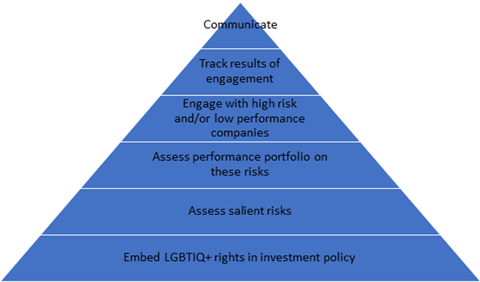We would like to thank Frank Wagemans of Achmea IM for his extensive input, which we highly appreciate
In recent years, investors have been paying increasing attention to diversity, equity and inclusion – in part as a result of social justice protests that have swept the globe.
An important aspect of diversity in the workplace is the inclusion of LGBTIQ+ employees. Despite progress in corporate culture, legislation, and regulations, LGBTIQ+ employees still face challenges and hardships in their daily lives – including in the workplace.
According to the campaigning group Stonewall, even in countries where workplace protections exist, discrimination and harassment at work is widespread*. For example, a 2019 survey commissioned by the European Agency for Fundamental Rights found 43% of LGBTIQ+ people reported they had personally faced discrimination in 2019 compared to 37% in 2012.
The Shareholder Case for Inclusion
We believe that there are both moral and financial arguments which support creating inclusive workplaces.
The moral argument is clear – all individuals should have equal rights and access in society to ensure their full participation. The business case is also compelling. Research supports the existence of many positive links between LGBTIQ+ supportive policies and outcomes that will benefit employers.
For example, Open For Business, a coalition of leading global companies dedicated to LGBTIQ+ inclusion, has identified 27 distinct propositions linking LGBTIQ+ inclusion with increased economic, business and individual performance.
Many global businesses have taken a leadership role by implementing sexual orientation and gender identity nondiscrimination protections, or offering equitable benefits for LGBTIQ+ employees and families, because these initiatives correlate with higher employee engagement, productivity, and retention rates – directly impacting the bottom line.
By LGBTIQ+ we mean
The abbreviation LGBTIQ+ includes everyone who is not heterosexual, and/or cisgender – a term used to describe a person whose gender identity corresponds to their sex assigned at birth.
Improving recruitment and retention for inclusion
In 1995 Trillium became the first US investment firm to sponsor a shareholder proposal asking a company to add ‘sexual orientation’ to its non-discrimination policy.
In 2016, Trillium filed a shareholder proposal at Arkansas-based transportation company JB Hunt asking the company to amend its equal employment opportunity (EEO) policy to protect all (LGBTIQ+) employees.

At the time, LGBTIQ+ employees did not enjoy workplace protections against discrimination in Arkansas or 27 other states in the US. The proposal received a remarkable 54.7% vote.
In response, the board appointed an internal task force and developed a policy approved by its directors, extending protections from discrimination for its 19,000 employees across the country.
In an economy with a tight market for labour, retaining employees and reducing recruitment costs by signaling a welcoming environment to new hires benefits the company’s culture and the bottom line.
Incorporating LGBTIQ+ equality into responsible investing
Investors have an important role to play in advancing LGBTIQ+ equality and below we outline six steps around LGBTQI+ inclusion which can be incorporated into responsible investment practices. These six steps are inspired by the UN Guiding Principles on Business & Human Rights and the OECD-guidelines.
Figure 1. Six possible steps towards integrating LGBTIQ+ rights into investment policy and practice

1. Include consideration of LGBTIQ+ rights in your responsible investment policy.
2. Identify where LGBTIQ+ rights are most at risk in your portfolio.
a. Screen portfolios, identifying countries, sectors and companies where egregious, pervasive or longstanding patterns of discriminatory behavior exist, for possible exclusion.
3. Incorporating LGBTIQ+ friendly policies and practices into your engagement asks on diversity and inclusion.
a. Policy: Develop LGBTIQ+ friendly policies. (i.e. ensure LGBTIQ+ employees have the same rights and benefits as other employees).
b. Governance: Does a board member or board committee have responsibility for monitoring and tracking progress on diversity, equity and inclusion?
c. Corporate monitoring: Does the company, monitor employee satisfaction and capture feedback from their LGBTIQ+ staff?
d. Implementation: What additional steps have companies taken to protect LGBTIQ+ employees in high-risk countries?
e. Grievance mechanism: Are grievance mechanisms in place that are anonymous and/or confidential?
f. Remediation: What procedures exist to redress the damage caused by unsafe working conditions?
4. Track implementation and escalate when necessary.
a. Engage in regular monitoring of progress on LGBTQI+ inclusion and escalate when necessary. For example:
b. Raise the issue at annual general meetings.
c. Join forces with other investors.
d. Vote against remuneration and/or the nomination of board members if the topic is not sufficiently addressed at board level.
e. File a shareholder resolution on the topic.
5. Communicate how impacts are addressed.

Report on your policy, dialogue and voting in your engagement and voting reports.
We believe these steps can create a safer, healthier and more productive workplace for LGBTI+ employees and will have positive impacts for all employees. Corporate policies that foster inclusive workplaces by supporting LGBTIQ+ employees are more likely to be welcoming to all staff – resulting in lower staff turnover and increased job satisfaction and productivity – benefiting companies and ultimately investors.
* Over 40% of LGBT employees in a US study reported experiencing unfair treatment at work, including being fired, not hired or harassed because of their sexual orientation or gender identity. https://williamsinstitute.law.ucla.edu/publications/lgbt-workplace-discrimination/
































No comments yet